Fantasy! Arguably the largest and most popular speculative genre. Fantasy has been a part of literature, a part of storytelling, since the beginning of civilization. As long as there have been dragons, there has been fantasy. Fantasy continues to grow and flourish, with stories told in a multiple of ways, from a multitude of cultures, lush with the fantastical. New perspectives and styles lead to new sub-genres, and with fantasy, whew. There are so many fantasy sub-genres.
Like my science fiction sub-genre primer, this primer will not cover every fantasy sub-genre that ever was. That would take eons. Even then, there would be sub-genres missing. Plus, so many lines blur and intersect when describing fantasy sub-genres. A single novel, a single short story, can be many sub-genres of fantasy, and that is a beautiful thing. The limits do not exist, y’all.
Like my science fiction primer, this fantasy primer seeks to be a jumping off point for readers and writers seeking to explore this vast genre and all its offshoots. I will mention some classic examples, but I’m aiming to list a majority of contemporary examples. Those writing in fantasy today are redefining fantasy as much as redefining the sub-genres of fantasy. Classics are fun, they are roots in a way, but as readers, especially as writers, you need to stop and smell the new flowers.
What is Fantasy?
Merriam-Webster defines “fantasy” as “imaginative fiction featuring especially strange settings and grotesque characters.” Wow, is that broad. One could argue that all of fiction is fantasy under that definition (that would really cook some critics’ noodles). So let’s take it a step further.
From my research, many definitions of fantasy are nebulous, and sometimes ignorant. I read one definition of fantasy that said it’s “mostly medieval.” For most encompassing, I think MasterClass’s definition was pretty good:
Fantasy is a genre of literature that features magical and supernatural elements that do not exist in the real world.
From “What Is the Fantasy Genre? History of Fantasy and Subgenres and Types of Fantasy in Literature” written by MasterClass
I touched on this in my “What is Speculative Fiction” article. The line between fantasy and science fiction, and certain definitions of speculative fiction, often revolves around the question of whether it can exist (or might eventually exist) in the real world. Fantasy cannot occur in our world. It involves magic and/or the supernatural; it is beyond our world’s natural order.
Under that vast umbrella are sub-genres that are more specific in their magic, whether that revolves around the characters, setting, plot or all the above. Let’s tread into this ever-growing and wildly thick forest, shall we?
Fantasy Sub-Genres
High Fantasy
High fantasy is fantasy that does not take place in our world. It takes place in a secondary world, and that world has its own rules, limitations, and magic system. High fantasy books are often intricately built, sometimes with their own seasons, religions, flora and fauna, down to the very specifics of the world’s creation and mythologies. Everything you can think of is accounted for, which is often why a lot of high fantasy books are door stoppers, complete with a character list, glossary, and appendixes. However, if the author does it well, you’re not thinking about all that; you are completely immersed.
There are many sub-genres under high fantasy as well, such as sword & sorcery, heroic fantasy, etc.
Example: The Priory of the Orange Tree by Samantha ShannonWhile the book is a feminist retelling of St. George and the Dragon, the world Shannon creates is all her own. There’s magic, multiple empires with their own rules and religions, and lots of awesome dragons. One of my favorite scenes was a detailed description of a monarch wedding, set in a world where it didn’t matter what gender the monarch was or who they married. It was a ceremony that was based in tradition of this particular kingdom, and entirely gender neutral. Masterfully done. |
Low Fantasy
Fellow Book Rioter Michelle Anne Shingler wrote a great article in 2018 on low fantasy, with examples. As high fantasy is set in alternate world with its own rules and systems, low fantasy is set in our world, in all its mundanity, save for a small fantastical detail. Perhaps a character has a magical gift, or a supernatural event occurs that causes ripples through an otherwise normal world. The line between low fantasy and speculative fiction is often blurred. There are authors who arguably write low fantasy but would never describe their own book as such. Some authors of low fantasy include Haruki Murakami, David Mitchell, and Helen Oyeyemi.
For a deeper dive on high fantasy vs. low fantasy, check out Hannah VanVels’s excellent 2020 comparison article.
Epic Fantasy
Akin to high fantasy — and some books can be both epic and high fantasy — epic fantasy is usually set in an alternative world, but it doesn’t have to be. That’s the key here. Epic fantasy is also often defined by its plot. There is usually a cataclysmic, “epic” event that occurs that puts everything in the book into motion. Likewise, something equally epic and cataclysmic usually occurs to complete/resolve the story. Epic fantasies are often more than one book, as it requires a series for the characters to complete their quest.
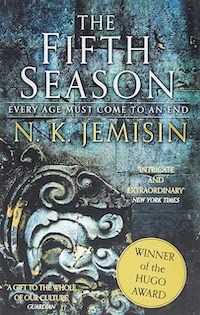
Example: The Fifth Season by N.K. JemisinThis is a textbook example of epic fantasy because the world, quite literally, is split into chaos. A rift splinters across the continent known as the Stillness, spewing ash that may change the sky for centuries. Essun embarks on a quest after she finds out her husband brutally murdered her son and kidnapped her daughter, but she must keep her own power a secret. This epic fantasy spans characters and lands, showing the brutalities committed by man and society. There is a reason this book won all the awards. |
Fantasy of Manners
I’m excited to include this sub-genre because I’ve seen a resurgence of it lately, namely in fantasy romance. If you’re searching for Pride and Prejudice but also want some magic to boot, this is the sub-genre for you. Fantasy of manners often shakes hands with historical fantasy, as most of these stories take place in the past or an alternative past. Some, though, take place in their own world but its etiquette is built very similarly to our own.
Think Zen Cho’s The Sorcerer to the Crown, India Holton’s The League of Gentlewomen Witches, and Oliva Atwater’s Half a Soul.
Historical Fantasy
This sub-genre alone encompasses a LOT of books. Historical fantasy is pretty explanatory, in that it is fantasy that takes place during a certain time period in the past. And then there are even more sub-genres that branch out below this sub-genre, specifying the time period, such as medieval fantasy, gunpowder fantasy, gaslamp fantasy, and more. For those wanting a deeper dive on gaslamp fantasy, I wrote a profile with examples.
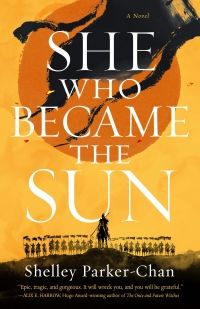
Example: She Who Became the Sun by Shelley Parker-ChanShelley Parker-Chan recently won the Astounding Award at the 2022 Chicago Worldcon. The Astounding Award goes to the best new science fiction or fantasy writer, and Parker-Chan absolutely deserves the award. She Who Became the Sun follows Zhu, who takes the place of her brother after his death to escape her own fate of nothingness. This novel takes place in 1345 China, which is under Mongol rule. It is a brutal, epic, historical fantasy. |
Grimdark Fantasy
Let’s get gritty! Grimdark fantasy gets deep under the nails of the dark side of fantasy. Grimdark fantasy and dark fantasy are very similar, often overlapping. Dark fantasy is a stone’s throw away from being horror, and definitely leans on horror elements at times. Grimdark fantasy carries a lot of similar elements, but it really focuses on a world and/or characters that are morally grey. Right and wrong are blurred. The main characters are probably not “good.” Think antiheroes and villain-centered fantasy. Fellow Book Rioter Emily Wenstrom wrote a magnificent deep dive into grimdark fantasy with the article “A Brief Guide to Grimdark Fantasy And Where to Start Reading It.” One example included is the epic grimdark fantasy book The Poppy War by R.F. Kuang.
Magical Realism
Many refer to magical realism in a similar vein to speculative fiction; it’s often used as an all-encompassing term for literary writing with fantasy elements. However, it is important to note that magical realism originated and belongs to Latine authors, and we owe them that distinction and respect. Authors in Latin America used magical realism in literature and art to reflect and portray the political turmoil that occurred around and between 1940s to 1970s, and it is still used today by Latine authors to explore other issues.
Like its name suggests, it is grounded in the real world, and includes magical elements, characters, and events. Unlike other fantasy genres — like high fantasy, where the magic is often described, defined, and discussed in minute depth — magical realism stories don’t often delve into the magical occurrences because they are accepted and part of this world. Many Latine authors were inspired by the indigenous mythologies and folklore of Latin America.
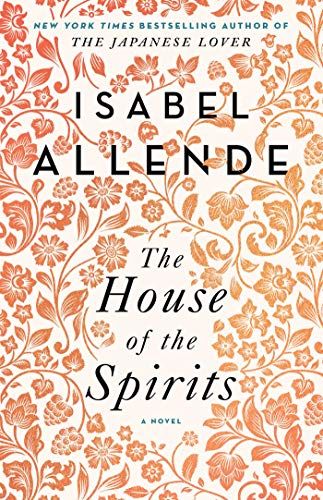
Example: The House of the Spirits by Isabel AllendeTwo authors come to mind when I think of magical realism, and they are Isabel Allende and Gabriel García Márquez. The House of the Spirits follows three generations of the Trueba family. It’s a saga family drama full of otherworldly gift and revolution. The House of the Spirits is one of the most beloved novels of the twentieth century, for Latin America and the world. |
Paranormal Fantasy
Paranormal fantasy often shares a bed with urban fantasy, likewise with paranormal romance. The main creatures from our imagination usually take front and center: vampires, werewolves, shapeshifters, witches, etc. The way to differentiate paranormal fantasy from urban fantasy is based on setting: Urban fantasy must take place in an urban environment, whereas paranormal can take place anywhere. Paranormal romance has all the trappings of paranormal fantasy, but the love story is central and takes priority over the other elements.
Ilona Andrews is a renown author of paranormal fantasy, urban fantasy, and paranormal romance. In her Kate Daniels series, there are books in the series that are paranormal romance, but the main romance doesn’t take off until closer to book three and four. With that in mind, I’d define the series as paranormal and urban fantasy (most books take place in an alternate Atlanta, but some books take place elsewhere). While the romance between Kate Daniels and Curran is central and amazing, the conflict of Kate Daniels with her god-like magical father, I think, is more central to overall series. Feel free to debate, though because I love talking Kate Daniels.
Portal Fantasy
This is one of my favorite types of fantasy in that it can break and reshape so many rules. Portal fantasy often intersects with science fiction, in that there are parallel universes, worlds, and selves. Merriam-Webster defines “portal” as a “door or entrance, especially a grand or imposing one.” Fellow Book Riot writer Annika Barranti Klein defined portal fantasy as “[when] a person is transported from one world to another by some sort of magic, usually (but not always!) through a specific place or object such as a wardrobe, rabbit hole, or mirror” in her fantastic in-depth list “50+ Must-Read Portal Fantasy Books.”
Portal fantasy is fun because it helps solve a lot of problems for authors while creating so many imaginative outcomes for the reader.
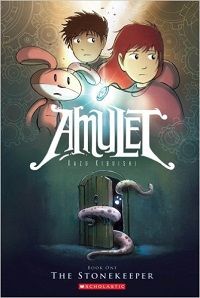
Example: The Stonekeeper (Amulet #1) Kazu KibuishiI got this book for my nephews for the holidays last year. This graphic novel has a pretty classic portal fantasy factor: a door in a basement. Can’t get much portal than that! The story follows siblings Emily and Navin as they move with their mother to the house of their great-grandfather after their father’s tragic death. Things get weird when their Mom is lured to a door in the basement by a dangerous creature. |
Urban Fantasy
As described under paranormal fantasy, urban fantasy must take place in an urban environment. The city needs to be key to the plot and characters. Jim Butcher’s longstanding series The Dresden Files comes to mind, as it follows a wizard P.I. in Chicago. Patricia Briggs’ Mercy Thompson series another example, which takes place in the Tri-Cities and follows coyote shifter Mercy Thompson navigating a world of paranormal creatures and solving murders. If it takes place in and among a metropolis, it’s urban fantasy.
FANTASY ROMANCE
Fantasy romance is different from paranormal romance in that, while paranormal romance is grounded in the real world (or at least a real alternative world) and often set in modernized times, fantasy romance can take place anywhere and at anytime.
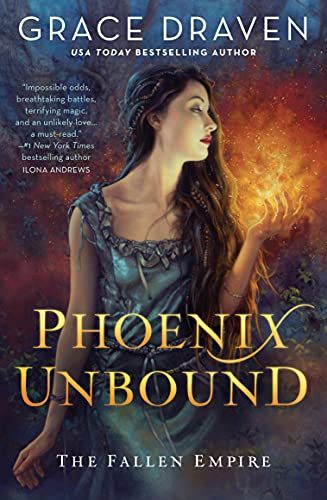
Example: Phoenix Unbound (The Fallen Empire #1) by Grace DravenFor me, Grace Draven is the gold standard for fantasy romance. Draven creates her own worlds, hierarchies, religions and mythologies from the ground up. There are dragons, fire witches, and creatures from all corners of our imagination. Then she adds heart-wrenching, beautiful romance. Radiance is what started my love of Draven’s work, but Phoenix Unbound branded me with its conflicts, characters, and fiery love story. The ending made me want to melt to the floor. |
Science Fiction Fantasy
Yeah, baby, I went there. Books can be, have been, and will be, both. I’ll say it again: the limits do not exist! A lot of examples of this sub-genre include a post-apocalyptic world that now has paranormal elements, like magic and monsters. Or perhaps there is a technology based in magic. Many authors today are raising the bar and breaking out of the constraints of sub-genre labels, and examples of science fiction fantasy (or fantasy science fiction) are a great place to start if you really want to get your mind blown.
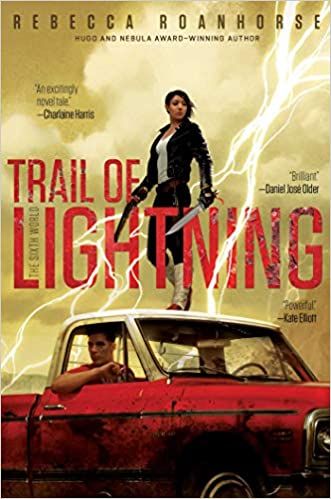
Example: Trail of Lightning (The Sixth World #1) by Rebecca RoanhorseRoanhorse’s Sixth World series is set in a world ravaged and drowned by climate change (science) and now old gods and monsters roam the earth (fantasy). This book can also be defined as dark fantasy, as the beginning scenes follow Dinétah monster hunter Maggie Hoskie while she hunts a monster that kidnaps and feasts on a child. |
Fantasy All the Way Down: The Future of Fantasy Sub-genres
There are so many more sub-genres that could be listed, and I truly wish I could log every one. I highly recommend you search Book Riot’s archives if you’re interested in a particular one; chances are there is a fantastic profile or list to scratch your itch.
And underneath the above sub-genres are many more sub-genres, mixing and matching with sub-genres from other genres as well. It’s fantasy all the way down, y’all! This beautifully complex genre will continue to evolve, and I can’t wait to see what stories we’ll be treated to in the coming years.
Source : It’s Fantasy All the Way Down: A Fantasy Sub-genres Primer










